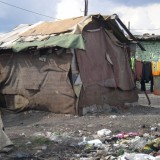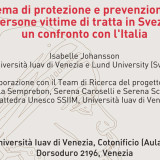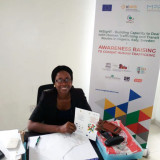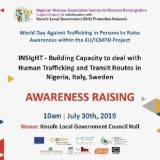 SSIIM Paper Series Vol. 13
SSIIM Paper Series Vol. 13
Migrants Sharing the Streets of Cairo – Can they Assert their Right to the City?
A Case Study of Sudanese Migrants
by Maysa Ayoub
download pdf
This paper is a study on international migrants settled in the more than 14 million people metropolitan area of Greater Cairo. The focus is on Sudanese, who represent the largest and oldest group of immigrants in Egypt, most of them living in Cairo. In particular, it is explored how Sudanese street vendors are negotiating and sharing urban space (and their right to it) with poor Cairenes. Through analyzing the use of public space, the paper aims to shed light on the day-to-day interaction between locals and migrants and understand the daily practices that allow or hinder migrant’s inclusion in the city life. The profound changes occurred in these processes after the Egyptian revolution are also highlighted.
————————————————————————
 SSIIM Paper Series Vol. 12
SSIIM Paper Series Vol. 12
Foreign workers in Tel Aviv and political innovation: the redefinition of citizenship in Israel
by Caroline Rozenholc
download pdf
Scientific research and daily urban experience show that globalisation increases mobility and contributes to the circulation of norms and life-styles across the globe. Yet, it also frames the diversification of socio-spatial belongings and the reinforcement of territorial claims. In this context of identity reconfigurations, Israel and more over Tel Aviv offer a fruitful but neglected field of research. Three main reasons explain the difficulty to consider Tel Aviv a legitimate fieldwork for exploring social and geopolitical issues. First, the city is mostly perceived, inside and outside of Israel, as a global and prosperous “bubble” oblivious of the geopolitical context. Second, the Israeli-Palestinian conflict remains unsolved and most social scientists focus on conflict zones and situations. Last but not least, “methodological nationalism”, if we refer to U. Beck’s work (2002), and State categories prevail in the Israeli social sciences research. Nonetheless, this article shall demonstrate that Tel Aviv offers a valuable vantage point for capturing transformative processes taking place in the Israeli society. It will do so by focusing on the presence of migrant workers in Tel Aviv and the impact they have had on citizenship. The way Tel Aviv’s municipality addressed the issue of migrant workers shows a growing disjunction between local municipal policies and governmental national policies: by integrating work migrants as full-fledge residents of Tel Aviv, the municipality started building a narrative that occasional overcame governmental discourses and practices and pushed the Parliament to make an historical step and grant resident status to children born in Israel to foreign parents.
————————————————————————
 SSIIM Paper Series Vol. 11
SSIIM Paper Series Vol. 11
Urban Citizenship and the Right to the City in cities in the United Arab Emirates
by Kaja Kühl
download pdf
This paper discusses the spatial and social consequences of development in Abu Dhabi, where migrants outnumber the local population. The cities of the United Arab Emirates, Abu Dhabi and Dubai are among the fastest growing cities in the Middle East. Most of this growth is enabled by the work of migrants from South Asia, who constitute a stunning 89% of the population. The paper focuses on concepts of citizenship and identity and illustrates how both are constructed and shaped by urban planning and economic development policies. In addition to field research conducted in 2011, this paper draws from a review of planning and policy documents, and from international reports and literature on human rights and the right to the city. Given the large number of foreigners living under challenging conditions within the borders of the UAE, questions of local identity arise as well as questions of human rights violations. This paper suggests the “Right to the City” concept as a useful framework to address both questions, deliberately plan for the urban inclusion of all citizens and build a robust urban culture.
————————————————————————
 SSIIM Paper Series Vol. 10
SSIIM Paper Series Vol. 10
New Diversities in Istanbul: Setting a research agenda for studying migration and the city
by Kristen Biehl
download pdf
Through presenting the case of Istanbul, this paper aims to highlight the relevance and timeliness of setting a research agenda which locates dynamics around new and international migrations to the city within the particular context of urban space, which as both real and imagined embodies layered and conflicted meanings about living with diversity in the past, present and future. To this end, the paper is divided into three sections, focusing first on the unique history of migrations to Istanbul and the rich urban research tradition around these migrations, second on international migrations to Turkey and the state of research in this field, and third, on the study of multicultural co-existence in Istanbul through conceptions of cosmopolitanism.
————————————————————————
 SSIIM Paper Series Vol. 9
SSIIM Paper Series Vol. 9
Entre el centro y las periferias de la Região Metropolitana de São Paulo: la inserción territorial de los migrantes bolivianos en São Paulo
by Iara Rolnik Xavier
download pdf
This paper contributes to a deeper understanding of the socio-territorial insertion of Bolivian migrants in São Paulo Metropolitan Region, Brazil, by exploring the links between migratory processes and the logics underpinning the urban structure. On the basis of the analysis of quantitative data (in particular those of the year 2000 National Census), a polarization of their settlement patterns is observed: Bolivians are clustered in few very central or very peripheral spaces of the metropolis. The paper examine this fact showing that such a distribution is different and more complex than postulated by the common sense and previous academic works, usually focusing only on the central areas of the Metropolitan Region. Bolivians use and ways of belonging to these two places simultaneously shows that they are differently subjected to urban polarization and segregation drives. Upon these considerations, the work contributes to review the correlation between peripheral spaces and “the urban outcasts”, observing and learning from ‘places’ and their inhabitants.
————————————————————————
 SSIIM Paper Series Vol. 8
SSIIM Paper Series Vol. 8
Acceso diferencial a la ciudad. Identificaciones y estereotipos entre los hijos de inmigrantes bolivianos y paraguayos en Buenos Aires
by Natalia Gavazzo
download pdf
Considering that stereotypes are not just representations of society but might also become the social reality itself -by feeding social, cultural and religious exclusion of those considered “others”-, this paper examines the practices of identification performed by sons and daughters of “unwanted immigrants” in a particular urban context. The case study -Bolivian and Paraguayan “second generation” in the metropolitan area of Buenos Aires city- has been approached through a twelve-years long ethnographic fieldwork. Based upon information obtained through different methods – i.e. interviews with descendants, their parents and some institutional key informants (both at the national and municipal level); analysis of communitarian publications and public policies documents; direct observation of migrants associations’ activities – this study provides key means to understand the perspectives, policies and actions that local governments are implementing to foster intra-regional immigrants inclusion into the society, in particular in the largest city of the country. Furthermore, the observation of migrants’ descendants’ modes of use and appropriation of urban public spaces is used to grasp the ways in which they frame governmental perspectives and actions for identity building and accessing rights.
————————————————————————
 SSIIM Paper Series Vol. 7
SSIIM Paper Series Vol. 7
La inmigración en Bolivia, ¿fenómeno social inexistente o invisibilizado? el caso de los peruanos en La Paz y El Alto
by Mirko Marzadro
download pdf
Immigration in Bolivia normally is not considered as an issue. The demographic and socio-economic impacts of immigration during the XX century is not comparable to those of internal migration nor to the emigration process. However this articles highlights how immigration in Bolivia is becoming a relevant issue too. The Paper analyses the Peruvian immigration at the urban level in La Paz and El Alto, cities where the majority of immigrants in Bolivia are living. The first section provides an overview on the development of the national immigration (and emigration) laws during the last century; previous research findings are shared and statistic data on immigration (with particular attention to the Peruvian one) are commented. The second chapter is dedicated to the mapping of Peruvian civil society organizations in the cities of La Paz and El Alto. The third one addresses emerging issues: the policies that are governing immigration in Bolivia (concerning access to work, education, heath, etc.) and the administrative procedures that immigrants uses to be legal in Bolivia. As a conclusion, the article shows how social integration is rather a dual and complex process.
————————————————————————
 SSIIM Paper Series Vol. 6
SSIIM Paper Series Vol. 6
Not just passing through: international migrants in cities of ‘transit countries’
by Giovanna Marconi
download pdf
Starting from the observation that transit migration became only recently a matter of relevant concern for the discourse on international migration, this paper explores i) the reasons behind the growing political attention towards this issue and ii) the consequences and side-effects the politicization of this phenomenon generates in the crucial points of transit routes, i.e. cities of transit countries. It questions whether transit migration is just an important feature of modern human mobility or rather a political construction aimed at influencing involved stakeholders and lead them to collaborate in a global strategy of migration management. It’s a matter of space and time: how these are framed and by which actors to obtain specific effects. The cases of Tijuana in Mexico and Istanbul in Turkey are used to explore the local processes activated by the introduction of the category ‘transit migration’. In particular it is highlighted how international geopolitical interests are affecting the way in which cities react and respond to the presence of international migrants and, as a consequence, what are migrants’ modes of incorporation in the urban social and spatial fabric.
————————————————————————
 SSIIM Paper Series Vol. 5
SSIIM Paper Series Vol. 5
Positioning the Urban in Asia’s International Migration Flows
by Michael Leaf
download pdf
Although not without historic precedent, the system of population movements linking the countries of East and Southeast Asia is seen as remarkable for both its newness and for the speed at which it has grown relative to the other major migration systems in the world today. This paper briefly reviews international population movements within this region and discusses current factors and conditions that shape policies toward international migrants. Overall, it is found that in official policy terms international migrants are almost exclusively understood to be temporary labour migrants despite their recognized structural importance within the economies of both sending and receiving countries. The main emphasis of the paper, however, is on the roles and functions of the region’s urbanization in shaping flows and patterns of migration. A major section of the paper thus focuses on the situation of Indonesian migrants in Malaysia as a means for providing a finer grained analysis of these issues. In its conclusion, the paper lays out a basic framework for a research and advocacy agenda in support of the inclusion of international migrants in Asian cities and argues for the value of developing comparative studies of immigration and migrant inclusion in the cities of the region.
————————————————————————
 SSIIM Paper Series Vol. 4
SSIIM Paper Series Vol. 4
Contribuciones para una teoría de la segregación residencial y los mercados étnicos de los inmigrantes en ciudades de América Latina
by Tito Alegría
download pdf
In the last decades many cities in Latin America have received a growing number of international migrants, mostly from neighboring countries. Inside several of those cities some neighborhoods or zones present high concentration of foreign residents and/or economic activities guided mostly to the immigrants’ final consumption and managed by them too. This research conceptualizes the immigrants’ residential concentration as segregation by national origin, and their economic clustering as ethnic markets. This immigrant’s intraurban spatial pattern seems to be similar to that present in countries of the North, however in countries of the South the reasons of the immigrants’ spatial concentration look different in type or intensity. Even more, an interpretation does not exist on that spatial concentration emergence neither of its localization, for Latin American cities. The few cases that appear in the scant literature are the “China towns” in almost each great city, the concentration of Bolivians in Sao Paulo and of the Peruvians in Santiago. This research proposes for Latin American cities explanatory models for, first, the particular social marginalization that immigrants experiment generated by the local social structuring conditions; second, the mechanisms that produce the immigrants’ residential segregation and its localization inside the city; and third, the determining mechanisms of the formation of ethnic markets and its localization inside the urban area.
————————————————————————
 SSIIM Paper Series Vol. 3
SSIIM Paper Series Vol. 3
Practice of citizenship, practice of resistance: Mozambicans in Johannesburg, South Africa
by Elena Ostanel
download pdf
With the end of the apartheid regime and despite the strict immigration policies introduced since 1994, the number of foreign workers in Johannesburg, South Africa, has increased significantly up to approximately 7 percent of the city population. The Census 2001, recorded approximately 220.000 international migrants (6.7%) around 10.000 from Mozambique. In South Africa, one of the main obstacles to constructive thinking about international migration is the growth of xenophobic intolerance (Crush, 2005). Policy response is greatly influenced by the strong public perception that immigration is a threat to the economic and social stability of the local population. Starting form this assumption, the paper looks at some critical aspects of the relationship between Mozambican migrants and urban inclusion in Johannesburg. The paper wants to analyze the issue of citizenship looked at from the point of view of the practices immigrants put in place ‘to access’ the city, with special focus on security and public space. Self-governing initiatives that are neither planned nor provided by the local government poses major challenges to urban policies that address issues of social and spatial inclusion and has important implications for urban governance (Toner, Taylor, 2008).
————————————————————————
 SSIIM Paper Series Vol. 2
SSIIM Paper Series Vol. 2
Conexiones translocales y formación de territorios migratorios. El caso de los cochabambinos de Bérgamo
by Mirko Marzadro
download pdf
This paper focuses on the trans-local migration processes from Cochabamba (Bolivia) to Bergamo (Italy). It explores a deep rooted and complex international migration system which led to a very high concentration of Bolivians in a limited territory as the province of Bergamo is. About 20 thousand Bolivians are settled in Bergamo today, i.e. more than half of all Bolivians living in Italy. Over the last ten years this phenomenon started to emerge as a relevant social issue at the local level. The paper try to explain that such a migration system is based on two apparently independent processes that are instead strongly interconnected. On the one hand the Diocesan Cooperation of Bergamo is working in Bolivia since 1962; on the other, the migration process from Bolivia to Bergamo started during the early ‘70s. Through reference to theories on ‘transnationalism’, the paper aims at demonstrate how these two processes led to the creation of a ‘migratory territory’ made up of a ‘population’ (i.e. the Bolivian community in Bergamo plus all the people with whom they keep connections back home) and ‘actors’ structuring an international migration system.
————————————————————————
 SSIIM Paper Series Vol. 1
SSIIM Paper Series Vol. 1
Social and Spatial Inclusion of International Migrants: Local responses to a Global Process
by Marcello Balbo





